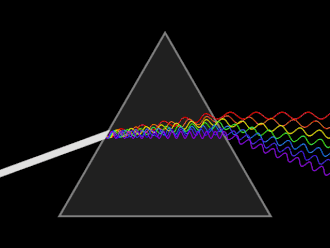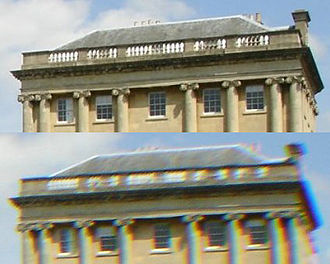Difference between revisions of "Chromatic aberration"
m |
m |
||
| (One intermediate revision by the same user not shown) | |||
| Line 7: | Line 7: | ||
Refraction is the bending of light by passing it through a medium. While the speed of light in a vacuum is approximately 300,000 kilometers per second, when light passes through a medium such as air, water, or glass, it is slowed. Different wavelengths of light, which are perceived by human eyes as colors, are affected to differing amounts. Light with shorter wavelengths, which appears bluer, is bent to a greater degree than is light with a longer, redder, wavelength. | Refraction is the bending of light by passing it through a medium. While the speed of light in a vacuum is approximately 300,000 kilometers per second, when light passes through a medium such as air, water, or glass, it is slowed. Different wavelengths of light, which are perceived by human eyes as colors, are affected to differing amounts. Light with shorter wavelengths, which appears bluer, is bent to a greater degree than is light with a longer, redder, wavelength. | ||
| − | [[File: | + | |
| + | [[File:Light dispersion conceptual waves.gif|thumb|Light passing through a typical prism.]] | ||
| + | |||
The same phenomenon is what makes a prism split white light into separate colors also causes chromatic aberration. In the example image to the right, as white light passes through the glass prism, the various colors of light are slowed at varying rates, causing them to bend, or refract. | The same phenomenon is what makes a prism split white light into separate colors also causes chromatic aberration. In the example image to the right, as white light passes through the glass prism, the various colors of light are slowed at varying rates, causing them to bend, or refract. | ||
In a typical glass [[convex]] lens, the glass is thicker in the center and thinner along the edges of the lens. When light passes through the glass, it is slowed down. Because there is less glass on the edges, that light is slowed less than the light closer to the center. This causes the path of all wavelengths of light to bent toward the center axis of the lens. Where the light rays all converge is the focal point. | In a typical glass [[convex]] lens, the glass is thicker in the center and thinner along the edges of the lens. When light passes through the glass, it is slowed down. Because there is less glass on the edges, that light is slowed less than the light closer to the center. This causes the path of all wavelengths of light to bent toward the center axis of the lens. Where the light rays all converge is the focal point. | ||
| − | But because red light is less affected than blue light, the focal point for red light will be further from the lens than it will be for blue light. | + | But because red light is less affected than blue light, the focal point for red light will be further from the lens than it will be for blue light as shown here: |
| + | |||
| + | [[File:Chromatic aberration lens diagram.svg|Chromatic aberration lens diagram]] | ||
| + | |||
| + | The visible result is that objects in the view tend to be blurred somewhat. This is most easily noticeable in images of objects with distinct edges, particularly if there is also a significant contrast between colors or light and dark areas of the image. | ||
| + | |||
| + | |||
| + | [[File:Chromatic aberration (comparison).jpg|thumb|Above: an image without chromatic aberration, below the same image with chromatic aberration apparent.]] | ||
| + | |||
| + | Telescopes which use mirrors instead of lenses to gather and focus light are not subject to chromatic aberration as the light does not pass through glass. When an eyepiece is used, there may be some chromatic aberration caused by the eyepiece, though this is typically less noticeable. | ||
| + | |||
| + | The problem is exacerbated by the thickness of the glass the light is passing through. Lenses with a shorter [[focal ratio]] have a more distinct curvature to them, while longer focal ratios have less significant curvature. This means that in lenses with shorter focal ratios, the difference between the center of the lens and the edges is much greater than that of shorter focal ratio lenses. As such, the amount of slowing of the light is more varied in a shorter focal length lens, which increases the effect of chromatic aberration. For this reason, most simple single-lens refractors tend to have long focal ratios to reduce the appearance of chromatic aberration. | ||
| + | |||
| + | ==Reducing Chromatic Aberration== | ||
| + | |||
| + | A mentioned previously, longer focal ratios reduce the appearance of the aberration, bringing the various focal points of different wavelengths of light closer together. This was the earliest way of dealing with the problem. | ||
| + | |||
| + | The problem chiefly applies to [[Refractor|refracting telescopes]]. In | ||
| − | |||
| − | |||
==References== | ==References== | ||
<references group=""/> | <references group=""/> | ||
Latest revision as of 19:05, 25 May 2022
Chromatic Aberration is an optical aberration that occurs when light passes through a medium such as a glass lens which causes different wavelengths (colors) of light to focus at different focal lengths and degrades the image.
this page is a work in progress
Refraction
Refraction is the bending of light by passing it through a medium. While the speed of light in a vacuum is approximately 300,000 kilometers per second, when light passes through a medium such as air, water, or glass, it is slowed. Different wavelengths of light, which are perceived by human eyes as colors, are affected to differing amounts. Light with shorter wavelengths, which appears bluer, is bent to a greater degree than is light with a longer, redder, wavelength.
The same phenomenon is what makes a prism split white light into separate colors also causes chromatic aberration. In the example image to the right, as white light passes through the glass prism, the various colors of light are slowed at varying rates, causing them to bend, or refract.
In a typical glass convex lens, the glass is thicker in the center and thinner along the edges of the lens. When light passes through the glass, it is slowed down. Because there is less glass on the edges, that light is slowed less than the light closer to the center. This causes the path of all wavelengths of light to bent toward the center axis of the lens. Where the light rays all converge is the focal point.
But because red light is less affected than blue light, the focal point for red light will be further from the lens than it will be for blue light as shown here:
The visible result is that objects in the view tend to be blurred somewhat. This is most easily noticeable in images of objects with distinct edges, particularly if there is also a significant contrast between colors or light and dark areas of the image.
Telescopes which use mirrors instead of lenses to gather and focus light are not subject to chromatic aberration as the light does not pass through glass. When an eyepiece is used, there may be some chromatic aberration caused by the eyepiece, though this is typically less noticeable.
The problem is exacerbated by the thickness of the glass the light is passing through. Lenses with a shorter focal ratio have a more distinct curvature to them, while longer focal ratios have less significant curvature. This means that in lenses with shorter focal ratios, the difference between the center of the lens and the edges is much greater than that of shorter focal ratio lenses. As such, the amount of slowing of the light is more varied in a shorter focal length lens, which increases the effect of chromatic aberration. For this reason, most simple single-lens refractors tend to have long focal ratios to reduce the appearance of chromatic aberration.
Reducing Chromatic Aberration
A mentioned previously, longer focal ratios reduce the appearance of the aberration, bringing the various focal points of different wavelengths of light closer together. This was the earliest way of dealing with the problem.
The problem chiefly applies to refracting telescopes. In


